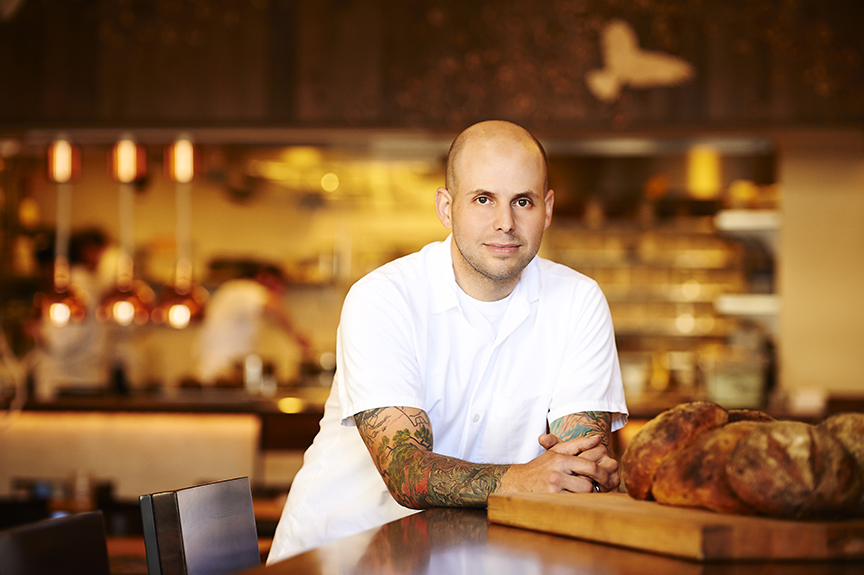The residents of Berkeley Heights, New Jersey are welcoming a new restaurant called Grain & Cane that has been inspired by traditional rice bags and offers a classic but enticing menu.
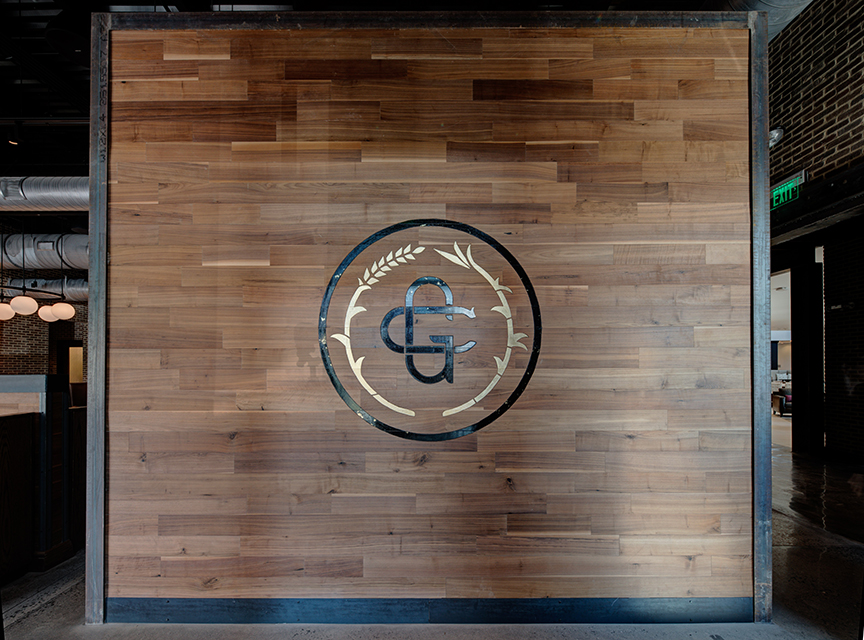
The new addition to Berkeley Heights is owned by the Connell family — who at one point was the largest non-governmental rice and sugar distributor in the world. Grain & Cane is the place where you might choose a quiet corner for an intimate evening or a cozy lunch date. It’s also the restaurant that you and your family might want to visit for a special celebration. The atmosphere is a unique combination of comfortable and chic, which makes it suitable for more than one type of occasion. There’s a distinct classic feeling.
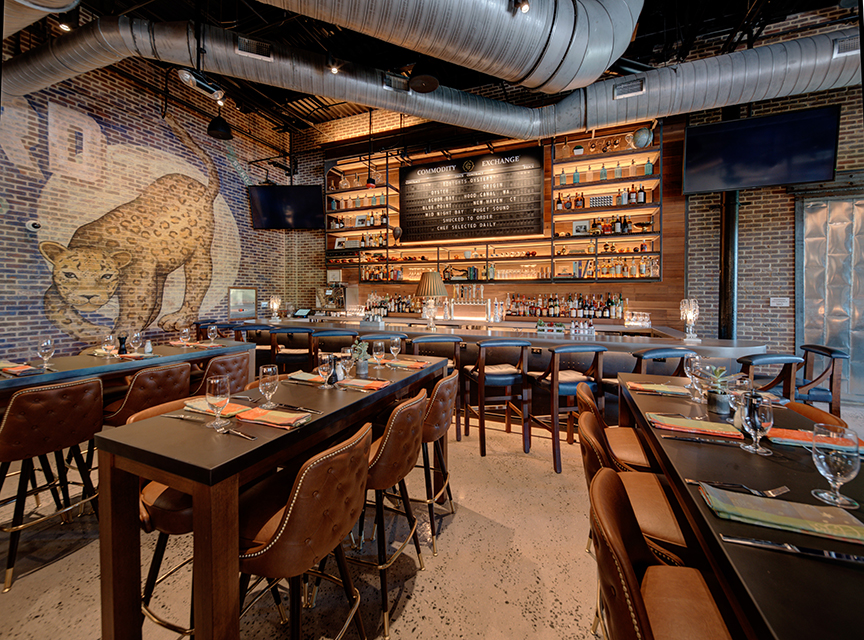
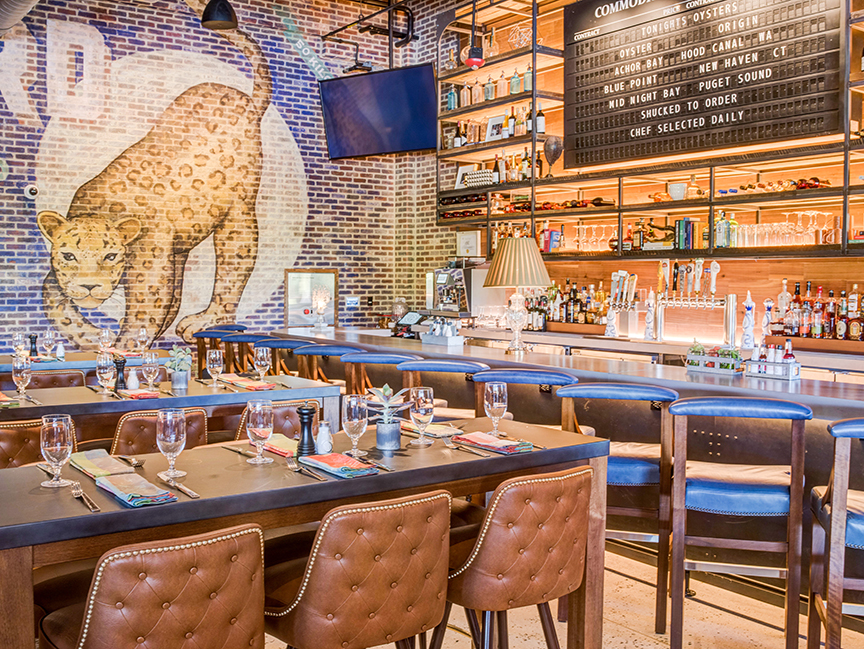
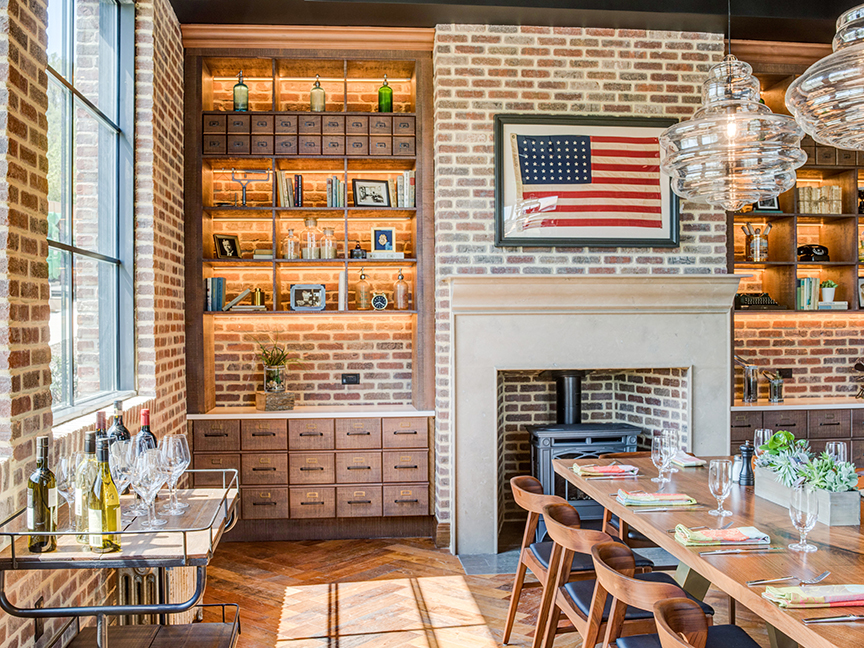
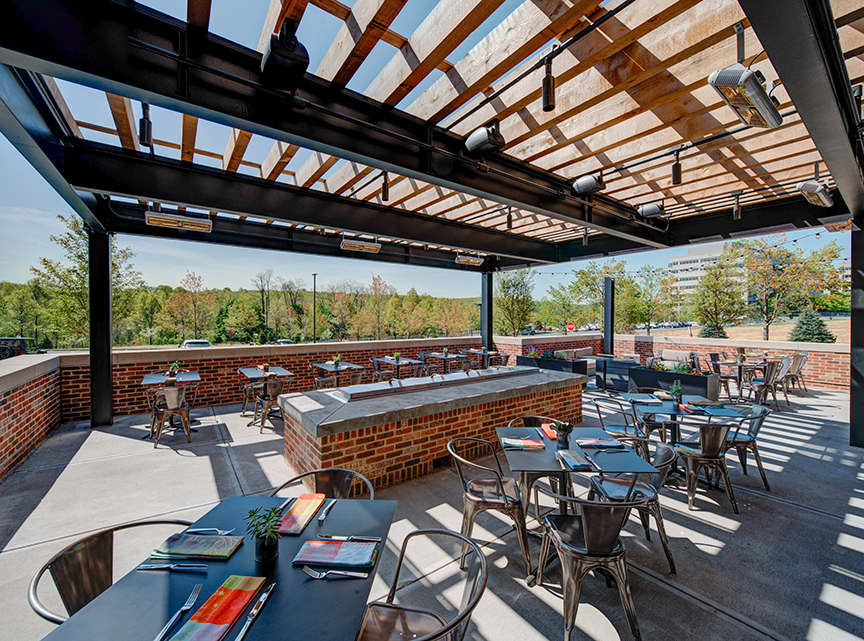
The floor-to-ceiling, weathered-looking graffiti draws the mind to traditional rice bags — the inspiration behind the restaurants’ decor. This style even includes using recycled rice bags as stool seat covers and of course some well-known brands and logos.Exposed brick walls and steel columns also draw on the family’s grain storage facilities. Tufted leather seating and custom banquettes are reminiscent of grandfather Grover Connell’s time in Paris, according to the Grain & Cane team. The main focus of the bar is the custom Solari board, which actually serves as the bar. It was once used for posting grain prices on the trading floor. Making this aspect even more special are the rotating specials and inspirational quotes from Connell, such as, “Cheer up, things could be worse. So he cheered up and things did get worse.” There’s also a two-story back bar for guests to enjoy.
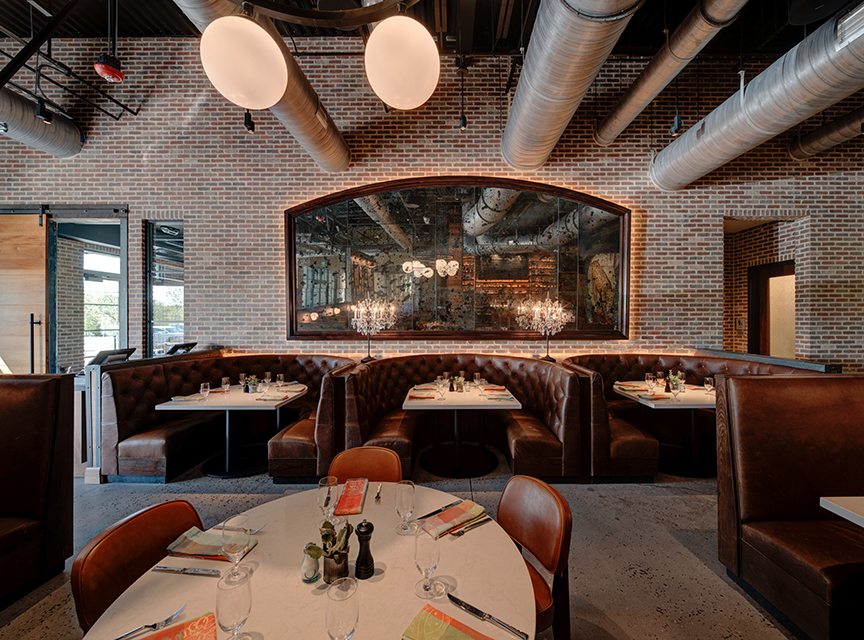
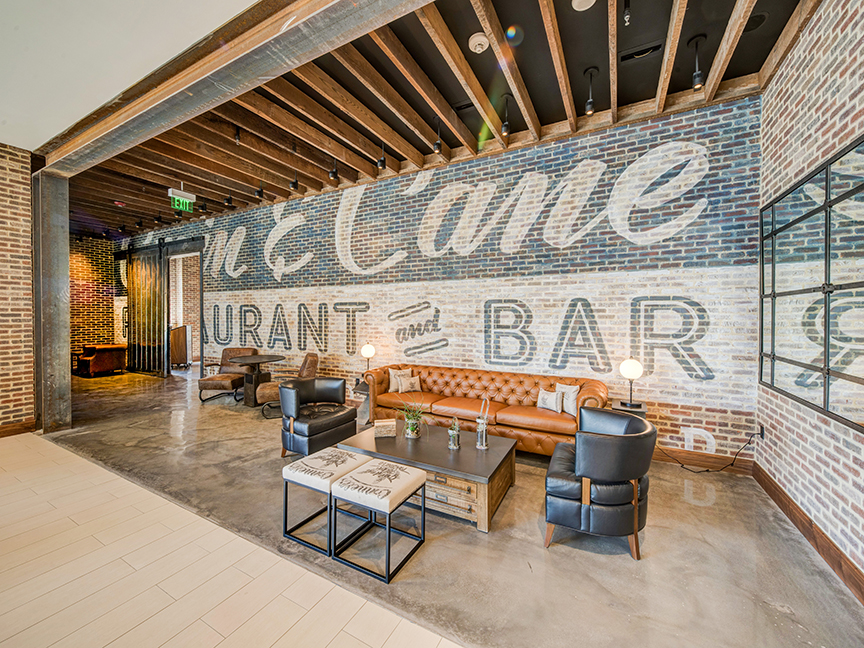
The menu has a refreshing variety of choices — without overwhelming guests — and known favorites. Traditional headlines, such as Burgers and Pizza, are splashed across the menu and instantly draw you in. Modern touches and complex flavors mix with classic at Grain & Cane
White, sausage, and margarita seem like standard pizzas, but the sourdough crust is a charming twist. A burger may sound simple, but the falafel burger with hummus and avocado tzatziki and the Scottish salmon with chanterelle mushrooms, roasted potatoes, peas, and crispy prosciutto are just a hint of the surprises on the menu.
Don’t expect the menu to stay the same for too long though. The restaurant has a menu that changes with the seasons and focuses on fresh ingredients from local farms and is peppered with items inspired by the Connell family’s favorite dishes.
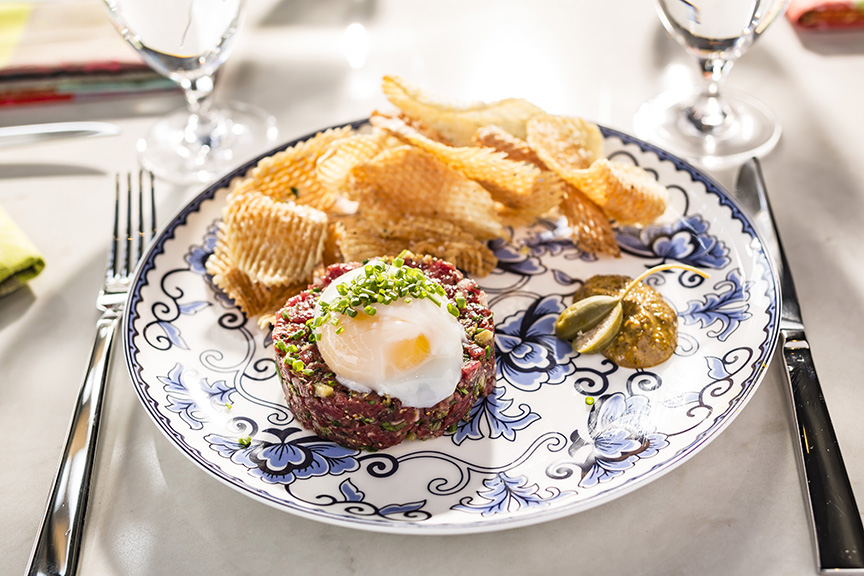

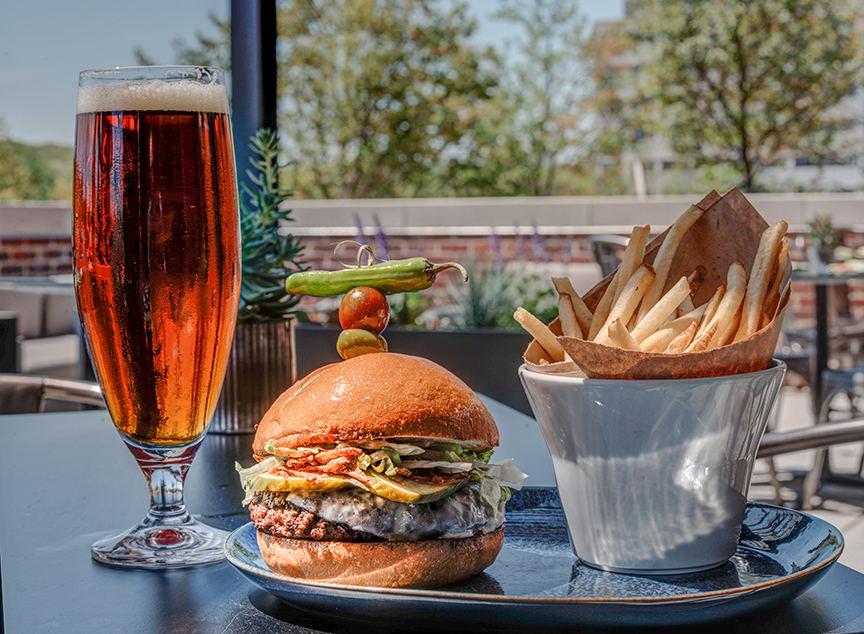
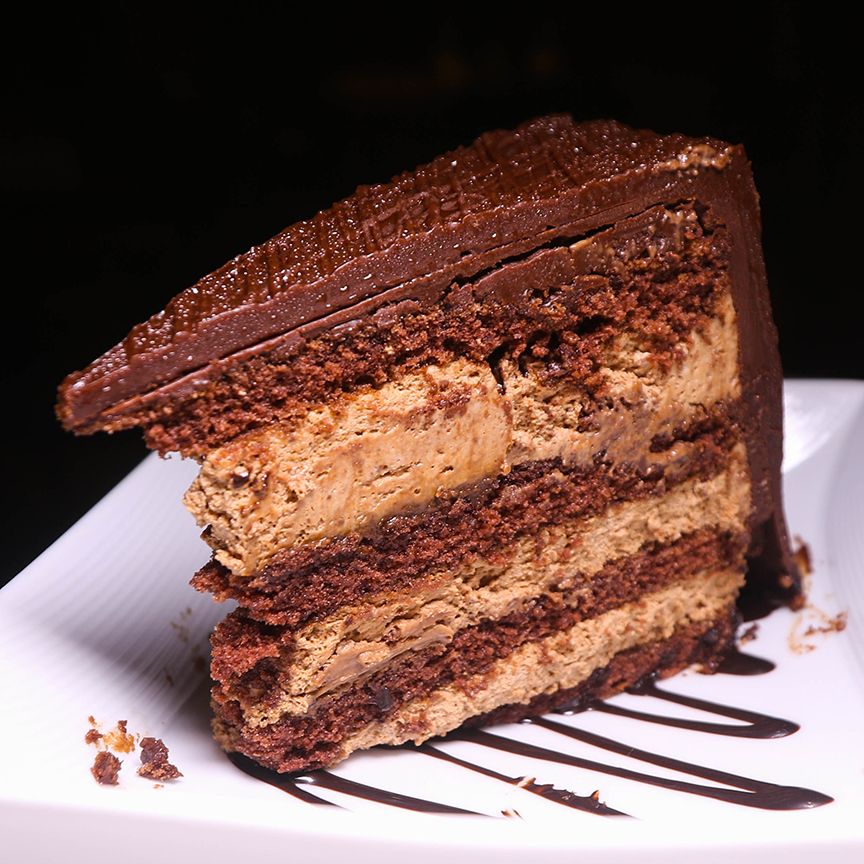
Making Grain & Cane truly stand out among tradition is their traveling food truck. According to the Grain & Cane team, the food truck allows the restaurant to park in different areas around town and reach a whole new set of customers and also introducing dishes to new communities.
Photos courtesy of Grain & Cane, by Oleg March
The wildly popular social movement “farm-to-table” encourages sourcing food locally, so that consumers know exactly where their food came from. Knowing the origin of your food encourages the freshest dining, and that can be found in these three dining options. These farm-to-table experiences have taken sustainability to a luxury level.
OUTSTANDING IN THE FIELD
Originally staging a handful of events in 1999, luxury farm-to-table dinner service “Outstanding in the Field” today stages 100+ multi-course feasts every year, from coast to coast across North America to all around the world.
Founded in 1999 by artist and chef Jim Denevan, “Outstanding in the Field” originally was a radical idea to switch up the traditional convention of dinner. Rather than sourcing ingredients and bringing them to the restaurant, Denevan’s vision was to create a restaurant at the source, where guests would enjoy a communal meal and the farmer’s story could be told and celebrated. A single long table is set at an extraordinary site, and guests dine outdoors on the food grown at the source.
“Our mission is to get folks out to the places where the food comes from and honor the people whose good work brings nourishment to the table,” says chef and artist Jim Denevan. “Our roving restaurant without walls may be located wherever good food comes from. There are no boundaries.”
“Outstanding in the Field’s” culinary caravan has visited all 50 U.S states and 15 countries around the globe. The #TabletoFarm tour season runs May through November, with a smaller winter tour in January/February to warm-weather spots like Florida, Hawaii and Mexico.




STUDIO IN MONTAGE LAGUNA BEACH, CALIFORNIA
Overlooking the Pacific Ocean in Laguna Beach, Studio is Montage Laguna Beach’s five-star free-standing fine dining restaurant. Studio prides itself on serving innovative modern cuisine. While Studio is known for its tasting menus and incredible service, it is also a Wine Spectator Grand Award winner, with approximately 2,500 wine selections and 30,000 bottles in inventory.
Studio’s showstopper is the 1,000-square-foot raised bed garden, which provides many of the ingredients for the restaurant’s signature cuisine. The garden is currently growing cucumbers, cherry tomatoes, Swiss chard, Valencia oranges, artichokes and edible flowers, to name a few. The culinary team at Studio uses the garden’s bounty in everyday cooking, especially in the restaurant’s gourmet vegetarian tasting menu, and also for fresh cocktail garnishes throughout Montage. The garden can seat up to 50 guests.
FLORA’S FIELD KITCHEN, MEXICO
Flora Farms is a 25-acre organic working farm at the foot of the Sierra de la Laguna Mountains in San Jose del Cabo, Mexico, and is home to Flora’s Field Kitchen, a field-to-table restaurant set amongst idyllic organic fields and gardens.
The original Flora Restaurant was in San Jose del Cabo, but after 5 years in town, the owner decided she would rather bring the restaurant to the farm instead of the other way around. Flora’s Field Kitchen prides itself on serving only what it has grown, even nixing beef from the menu, as it is not sustainable in the Baja region.
Flora’s has an onsite bakery firing up artisan breads, a butcher-shop, a brewery, and a wood-fired oven that serves up 15 types of Neapolitan-style pizza.. The restaurant also offers cooking classes several days a week.
Flora Farm is available for private gatherings and special occasions, with customizable event menus.




AGRICOLA FORE PORTA, ITALY
Only accessible on foot, this organic agriturismo, or farm resort, only uses seasonal, organic products, with the famous Amalfi lemons at the forefront of the fresh cuisine.
For Italians, the idea of combining agriculture with tourism is an old tradition, and this agriturismo started generations ago, when the farm was an old papermill. Agricola Fore Porta today offers a daily menu, which includes traditional courses prepared only with seasonal products picked freshly every morning, and Mediterranean cooking lessons, where participants will learn how to prepare local recipes.
Because there’s an endless wealth of kitchen, living room and bathroom interior design articles, we’re looking at one of a home’s most forgotten rooms — the dining room. As a gathering room often used, it’s odd that there’s little to no talk when it comes to dining room interior design and how to get it right in a contemporary residence.
And while redecorating a room is a fun challenge to take on, it can be a puzzle figuring out where to start and how to decorate effectively. To help inspire you to make the most of your dining room, Décor Aid is sharing easy-to-manage cues to consider to elevate the space. If your room doesn’t need a major overhaul, these are still tried and true, resourceful practices to take in to easily transform your dining room.
TRY A DIFFERENT LAYOUT
A dining room layout should offer a refreshing surprise — without being too daring. That said, do try your hand at thinking out of the box when it comes to exactly where you place your furnishings and how you can make them stand out objects.
USE WARM WOOD TONES
Wood tones can add a polished, warm vibe to a dining room of any size, even for small dining room decorating ideas. You don’t need to worry too much about matching wood tones as subtle nuances between flooring and furnishings allow the eye to travel.
Photo courtesy of Millarc

Blending warm wood tones, the dining area at 15 Jay St — located within the Tribeca West Historic District and designed by the Meshberg Group — also offers a unique, open plan layout.
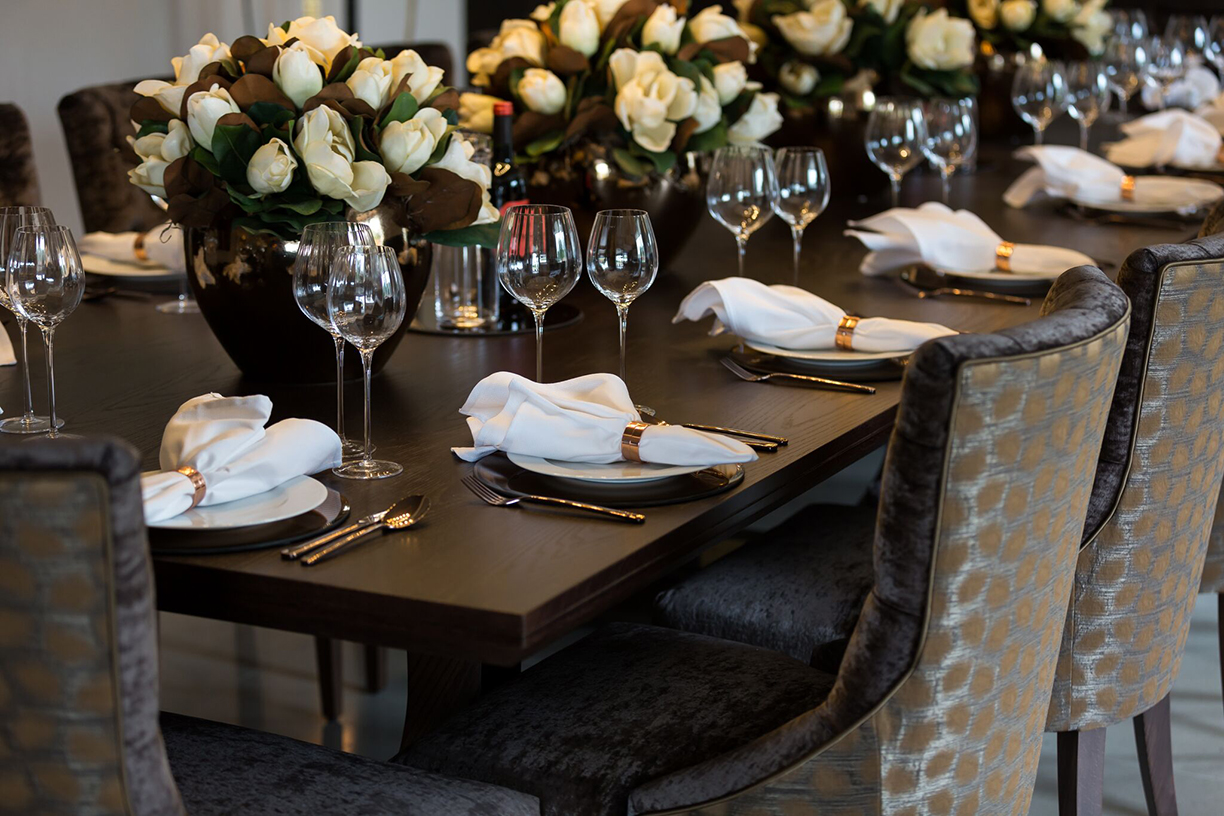
Photo courtesy of Quada
BE CREATIVE WITH TABLETOP DECOR
Easy to source and decorate with, consider different approaches for the items that live on your dining room table and/or console daily and move them around, rotate them, or add new items with little to no effort.
This dining table — located within Harford Manor, a 40-acre estate near Windsor, Berkshire — displays beautiful, elegant tabletop decor
BRING IN ART
Art can bring a sense of relaxed elegance into a space. Note how a vibrant painting gives the room depth and a sense of drama with just one piece.
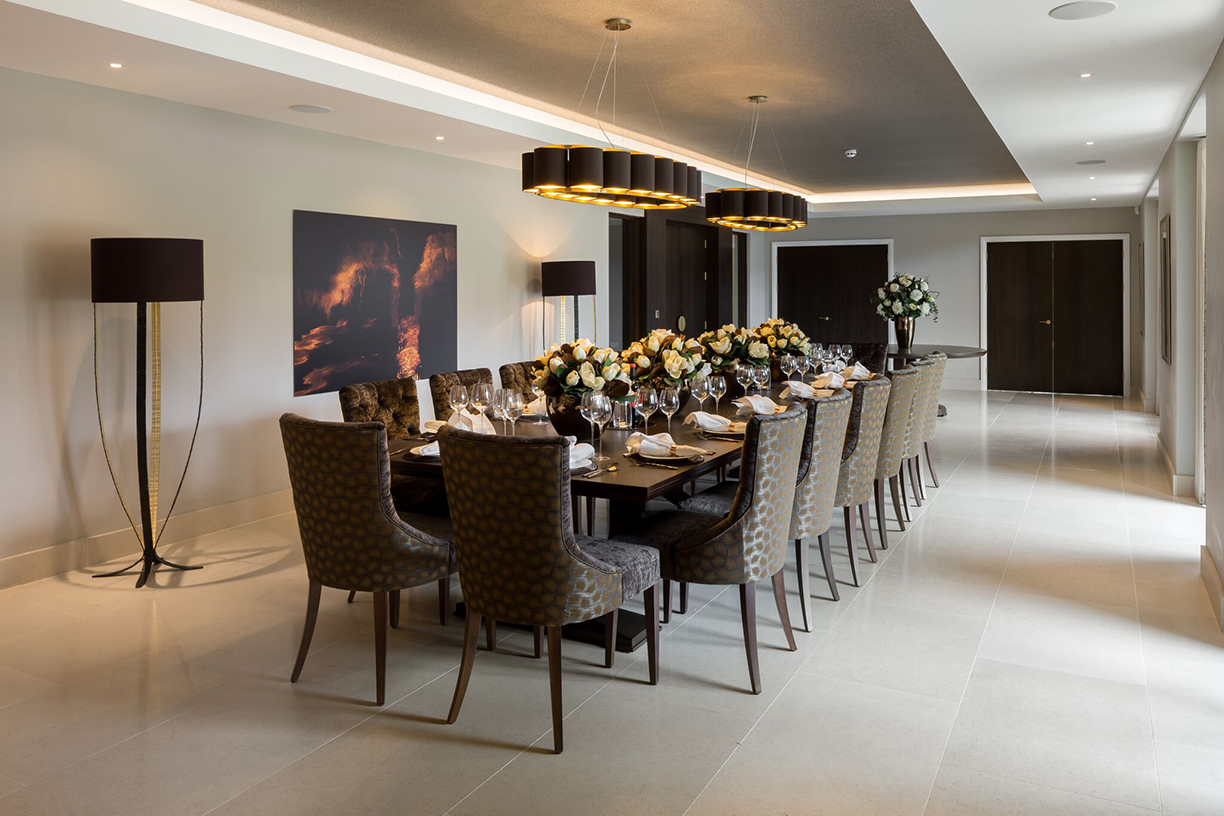
Photo courtesy of Quada
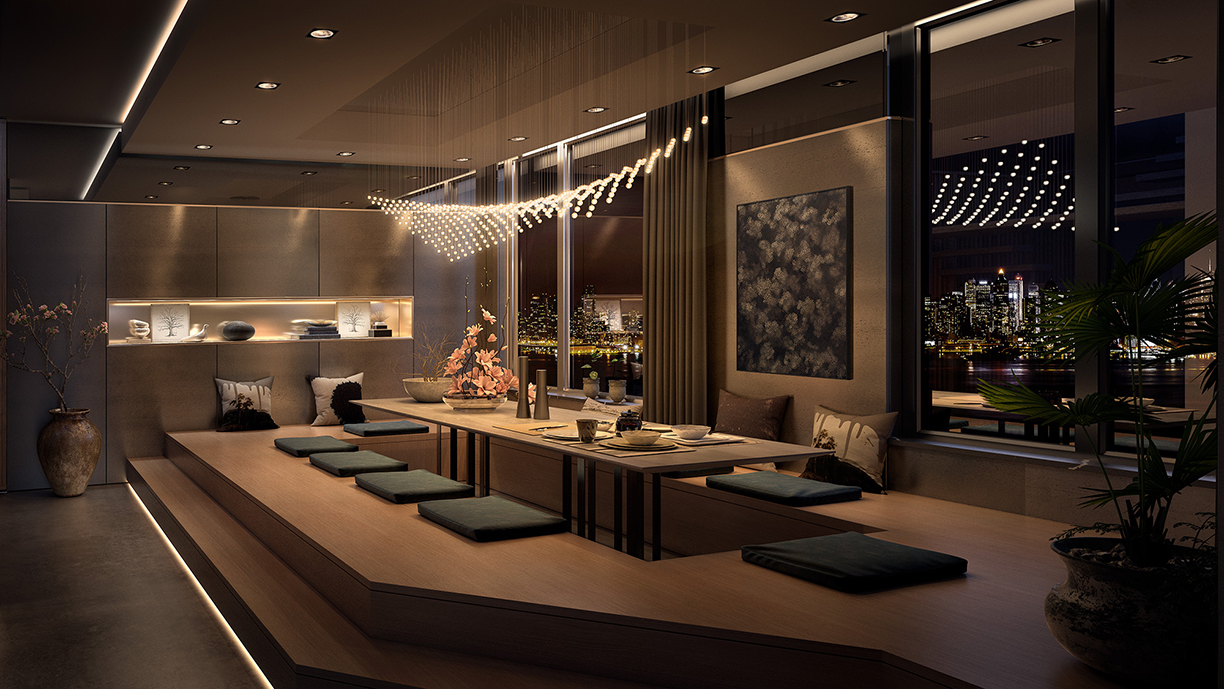
Photo courtesy of VDP
CREATE AN INTIMATE ATMOSPHERE
The more relaxing and comforting your dining room interior design is, the more you’ll want to entertain in it. Think a small grouping of furnishings that boast plush surfaces, relaxing hues, and what would make you feel at ease in an intimate setting.
This one-of-a-kind dining room — located within the Penthouse at Nine on the Hudson — was designed to bring people closer together with an intimate, less traditional arrangement.
GO OLD SCHOOL
As memories and culinary experiences are deeply linked, do transport your guests to moments from your past. Though we aren’t recommending a completely traditional overhaul, there’s comfort to be found in the familiar, so consider injecting your dining room interior design with elements that hint to the past whether through vintage quirk or a grand gesture.
Designed by Room Resolutions, this dining room features antique elements — including the traditional chandelier and detailed crown molding.
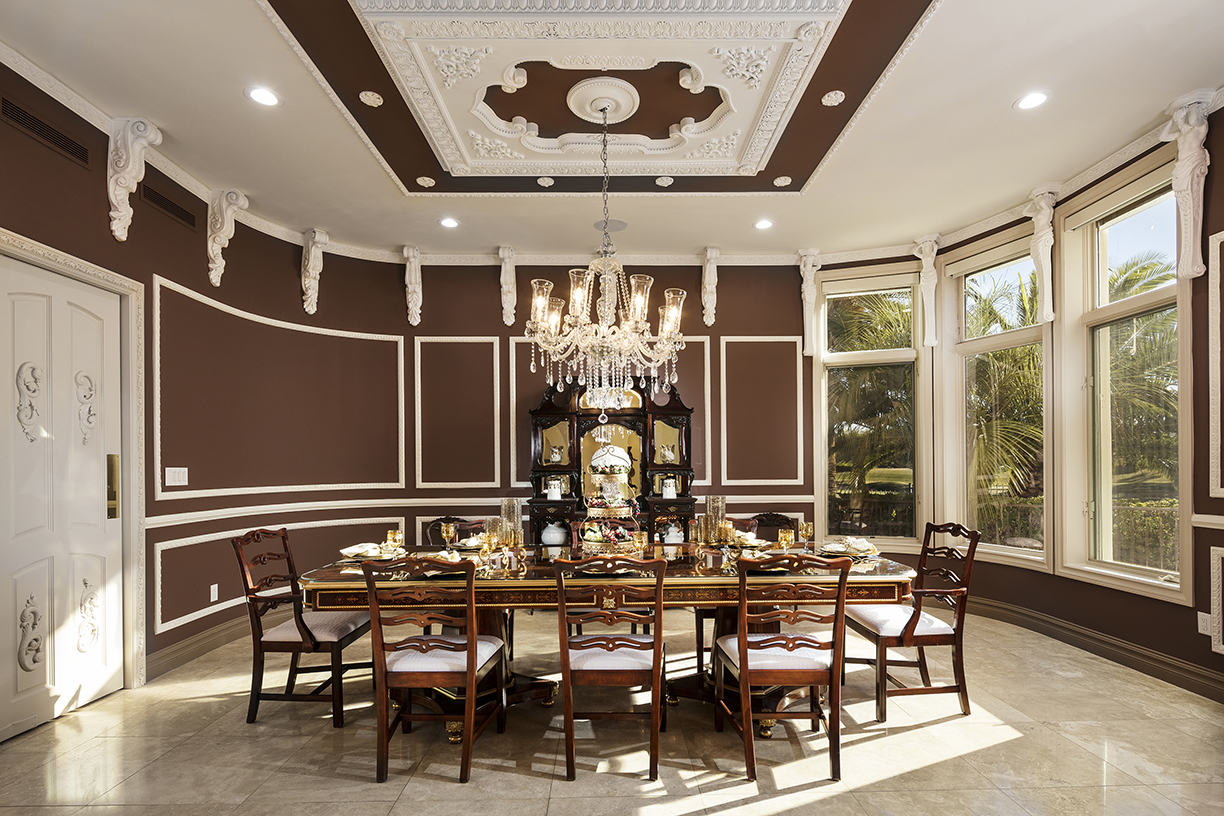
Photo by Shay Velich
For a complete list of Decor Aid‘s dining room design tips, head to www.decoraid.com


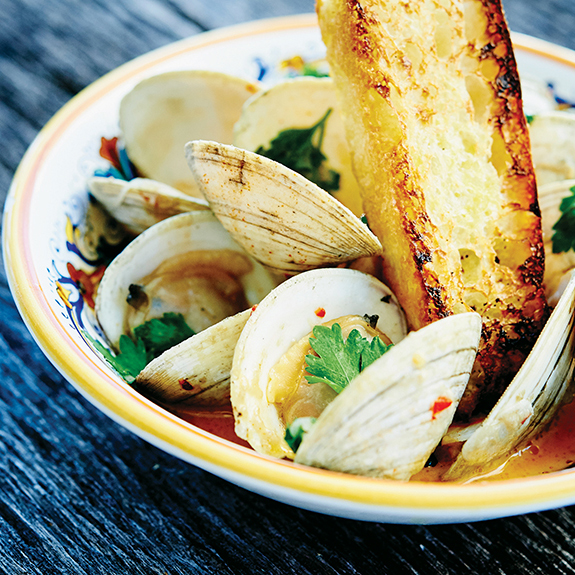
It may lack the culinary notoriety of San Francisco, New Orleans or the Big Apple, but St. Louis has quietly been developing a serious food scene. In addition to benefitting from a large Italian-American community and a geographic flirtation with the South, talented young chefs from around the country are arriving. Largely responsible for St. Louis’ dining renaissance is chef and prolific restaurateur Gerard Craft.
Craft, who grew up in Washington, D.C., opened his first restaurant in St. Louis knowing very little about the city except that it offered affordable space for a struggling 25-year-old chef. That restaurant, Niche, ignited the local dining scene and his Niche Food Group now operates five restaurants in the Gateway City.
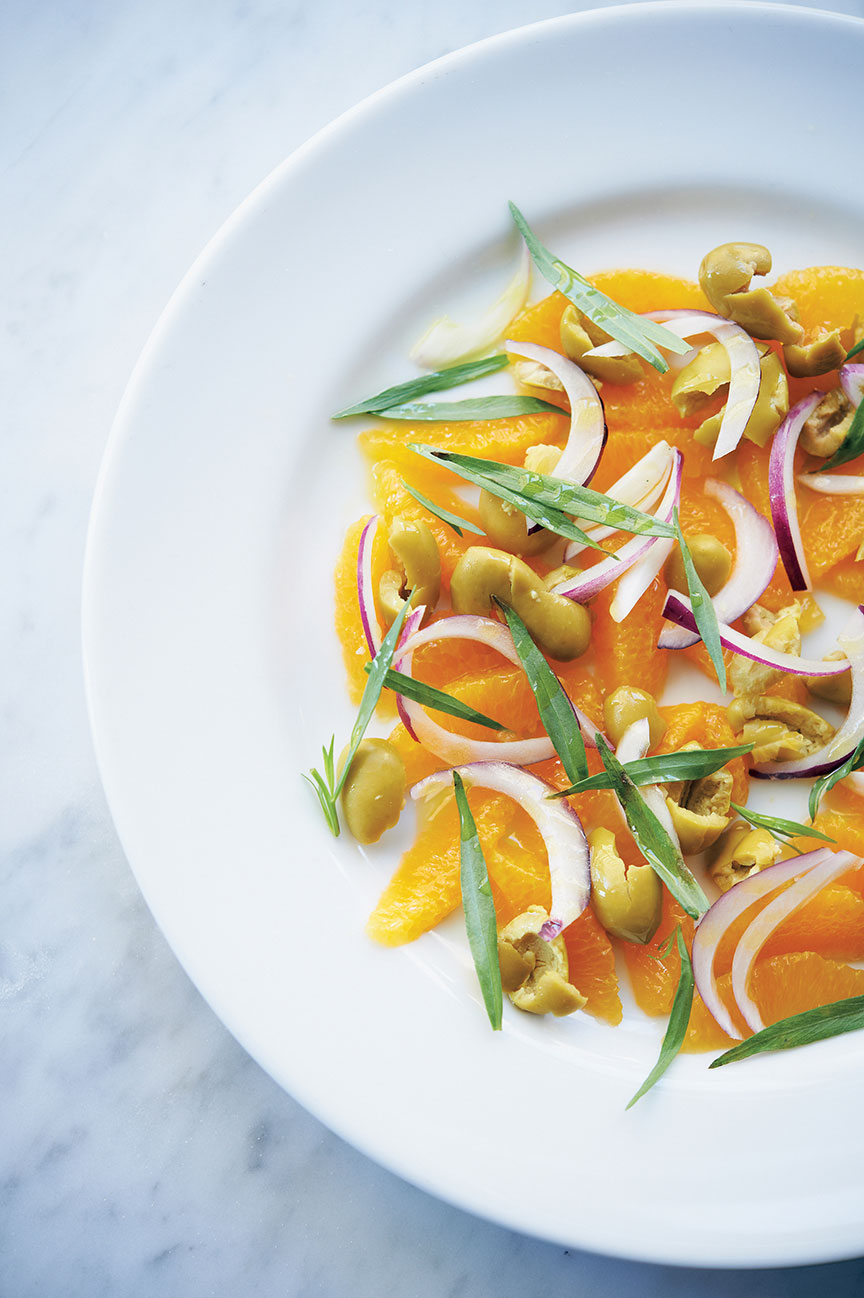
“I still wasn’t that interested in food, but fell in love with the kitchen’s energy, comradery and instant gratification. “I loved the idea that you could produce something, serve it and see the impact it has on people, then clean up and move on to the next day,” recalls the young cook. After spending some time in France, even enrolling in a work-study program at the Ritz in Paris, Craft was feeling confident enough to talk his way into a line cook position at Park City’s well-respected Bistro Toujours.
“It was a disaster,” reports Craft, explaining, “The chef sat me down and told me I had no skills and that I could either leave or work as a prep cook in the basement.” Now recognizing this as a turning point in his career, Craft says, “Being demoted was the best thing that ever happened to me. After I got some hands-on experience down in the basement, I was able to work my way through every station on the line.” After an apprenticeship at the upscale Ryland Inn in New Jersey, Craft earned a sous chef position at Chateau Marmont, a celebrity haunt on Los Angeles’ Sunset Strip.
Hearing that prominent chef Larry Forgione and some other talented chefs had opened restaurants in St. Louis, Craft flew there to look at an old wine bar for a potential restaurant of his own. “It had boarded-up windows, a dirt floor and no electricity,” recalls Craft, who took possession of the space in February 2005 and reopened it as Niche later that year.
Craft had little interest in cooking as a young boy, recalling, “My family was really into food, but I was probably the pickiest eater in the world.” Despite that self-characterization, Craft’s most meaningful food memories revolved around the cooking of his Brazilian nanny. “She was like a second mom to me, and I grew up eating simple, rustic Brazilian food like black beans and feijoada,” says Craft, who adds, “She had such a touch with food and was able to make anything taste great.” He honored that influential nanny by offering contemporary versions of pão de queijo (Brazilian cheese bread) and brigadeiro (confection) at Niche. “Having her visit the restaurant before she died was a big moment for me,” says Craft.
As a kid, Craft’s heroes were not Wolfgang Puck or Emeril Lagasse but Russell Simmons and Richard Branson, as the fledgling entrepreneur sold paintballs to classmates in fifth grade, a clothing line in high school. He attended Westminster College in Salt Lake City, a choice driven by his passion for snowboarding, but dropped out after two years. To supplement his income as a snowboard photographer, Craft began washing dishes and cooking at a local diner.
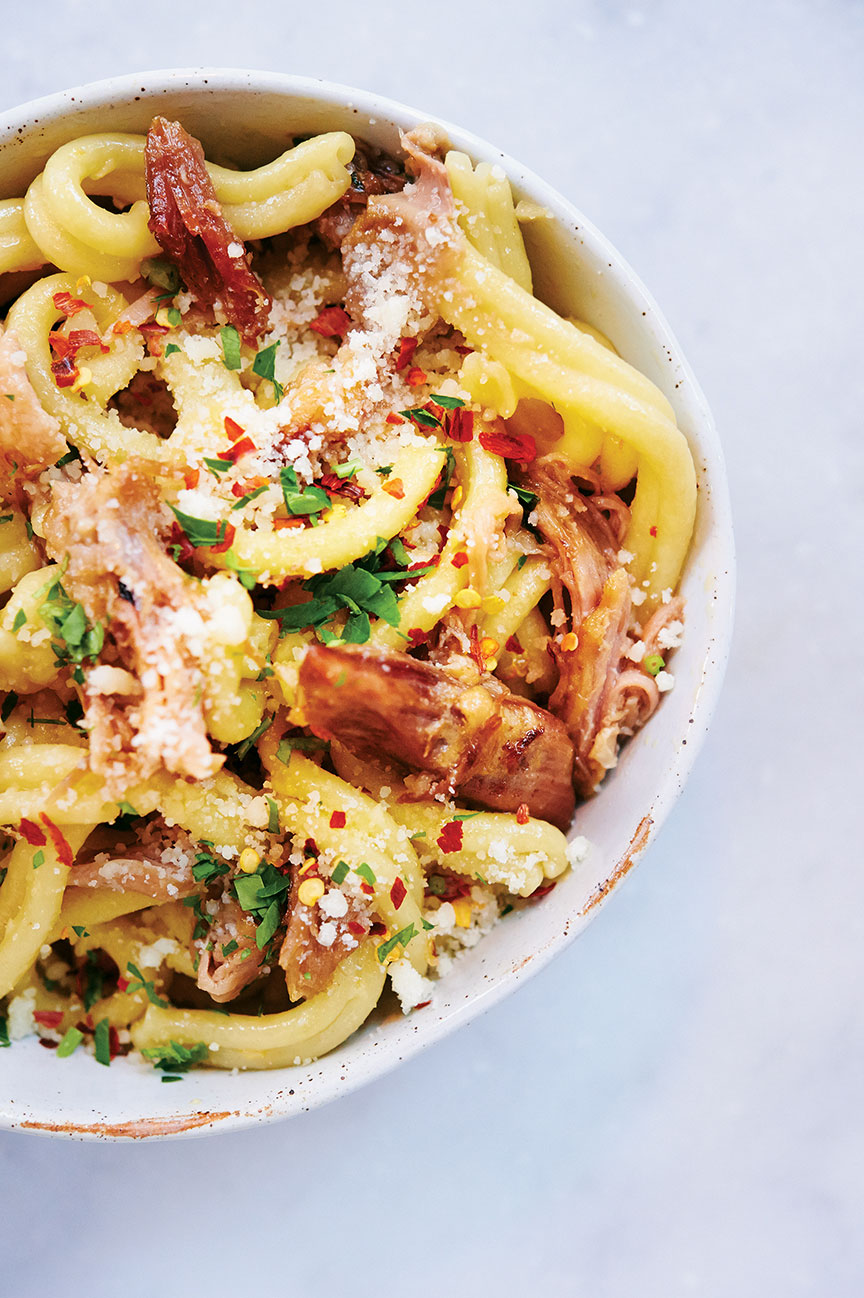
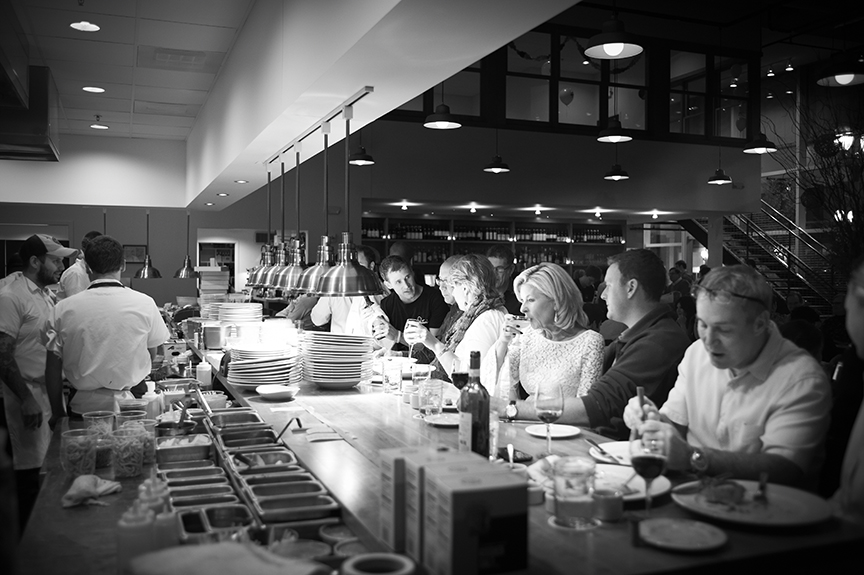
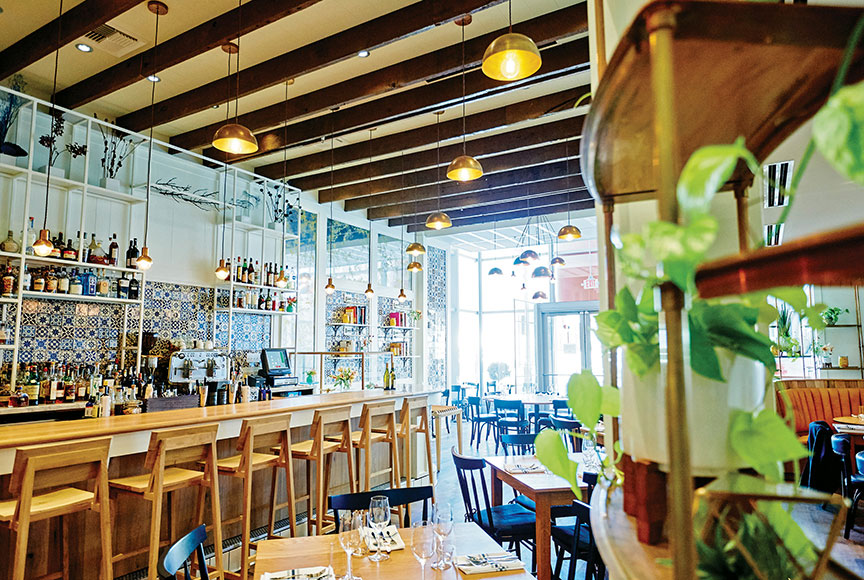
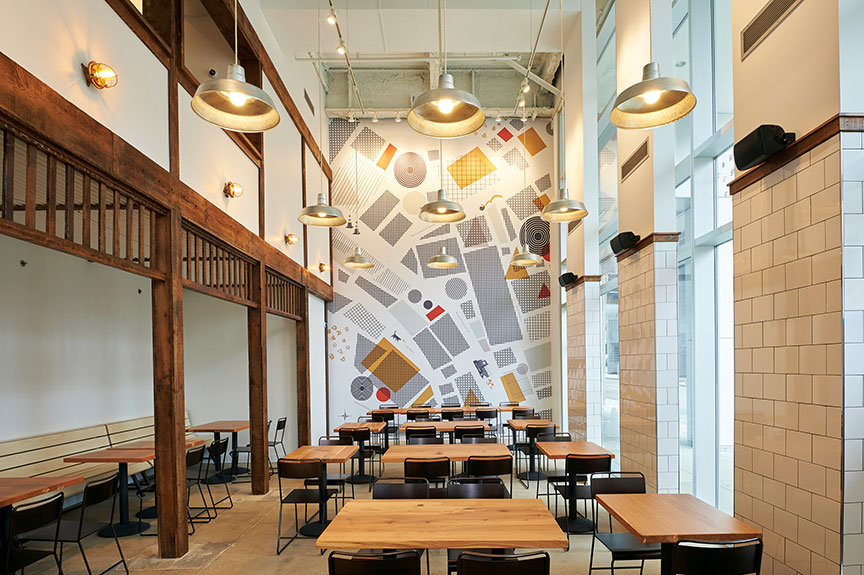
Niche was originally conceived as an unpretentious contemporary American restaurant, but an older clientele with fine dining expectations forced Craft to reinvent it as more of a special occasion restaurant. The servers, originally wearing tee-shirts, switched to collared shirts and pressed aprons, while the china was upgraded, explains Craft, who admits, “That slippery slope into fine dining pushed me to become a more creative and ambitious chef.”
Craft subsequently opened Brasserie by Niche, an authentic French bistro that reflects his love of Paris, Porano for quick-service Italian cooking, Pastaria for organic pastas, and mixology-driven Taste. While he acknowledges St. Louis lacks the wealth of dining found in its rival Midwestern city of Chicago, he contends, “There may not be a chic modern restaurant on every block, but the ones that succeed here are special.” In the pipeline for Craft is Pastaria Nashville, his first venture in neighboring Tennessee.
The James Beard Award-winning chef is perhaps the greatest single ambassador for Missouri-sourced ingredients. At the height of Craft’s commitment to local foods, 97 percent of the ingredients on Niche’s menu were produced in the Show Me State, including the onions going into stock for sauces, caviar from local rivers and even wine from Missouri vineyards. “It definitely generated a sense of pride in home-raised Missouri products,” says Craft. Insisting Missouri remains an unpretentious, approachable place, he suggests, “The hot summers and cold winters produce real people, and the vegetables are the same way, more humble and less precious.” Because of the movement that Craft spearheaded, there are now farmers and ranchers offering to grow vegetables or raise animals specifically for the needs of local chefs.
Craft shuttered Niche last year after a decade-long run, citing the intensity of maintaining standards at the city’s top-rated restaurant. “The competition begins to wear on you, and you begin to forget why you decided to cook in the first place,” says the chef, who converted the space into Sardella, a less expensive restaurant that celebrates his passion for Italian cooking.
A signature dish at Sardella is charred butternut squash with roasted garlic custard, Calabrian chile vinaigrette and basil that Craft describes as having bright flavors and a spicy, almost Thai-like quality even though all of the ingredients are Italian. “It’s an Italian dish that you’d never find in Italy,” quips the chef.
Gerard Craft and St. Louis have been good for one another, with the 37-year-old chef offering a diversity of local restaurants that may be the product of global influences but are true to their Missouri heritage.
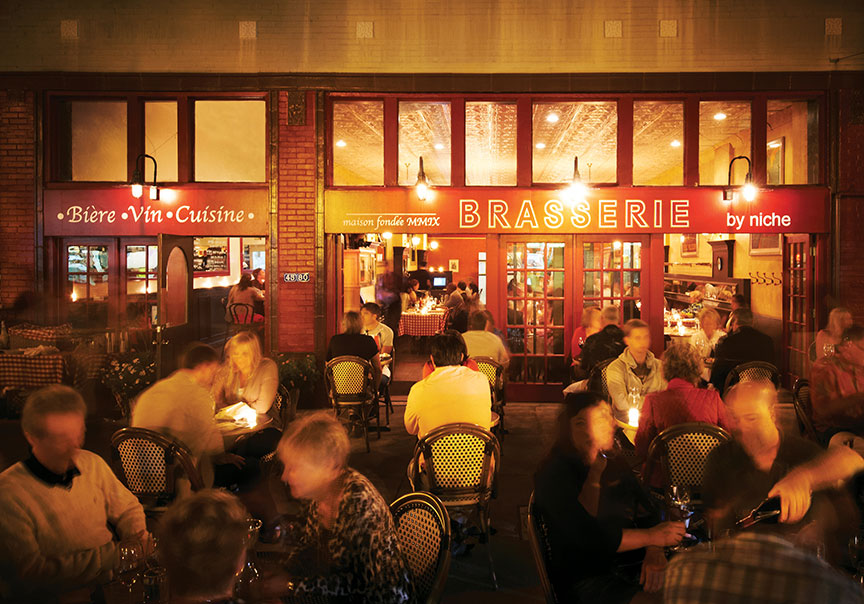
Photos courtesy of Greg Rannells
The classic American steakhouse— where an abundance of white linen, polished mahogany and brass create a comforting, masculine ambiance — is today more nostalgia than reality. Contemporary steakhouses now dominate the genre, where in addition to sleek modern décor, slabs of USDA Prime are being traded in for petite cuts of Japanese wagyu beef priced like jewelry.
The steakhouse, a quintessentially American dining tradition, continues a robust renaissance that began more than a decade ago. The classics — places like Sparks, and Smith & Wollensky in New York City or Gibsons in Chicago — remain popular, but talented young chefs are reinterpreting the venerable institution for a more sophisticated, diverse clientele. The traditional ribeye is still on the menu, but the days of pairing it with a baked potato and creamed spinach are fading in favor of caviar, truffles and some molecular gastronomic magic.
One of the first steakhouses to break with tradition and introduce diners to a new wave of contemporary beef palaces was Beverly Hills’ CUT, the Wolfgang Puck concept that has since been replicated in Las Vegas, New York, Singapore, London, and even Bahrain. The original Beverly Hills dining room, an über-sleek space incongruously carved out of the ornate, Italian Renaissance-style Beverly Wilshire Hotel, broke all the rules.
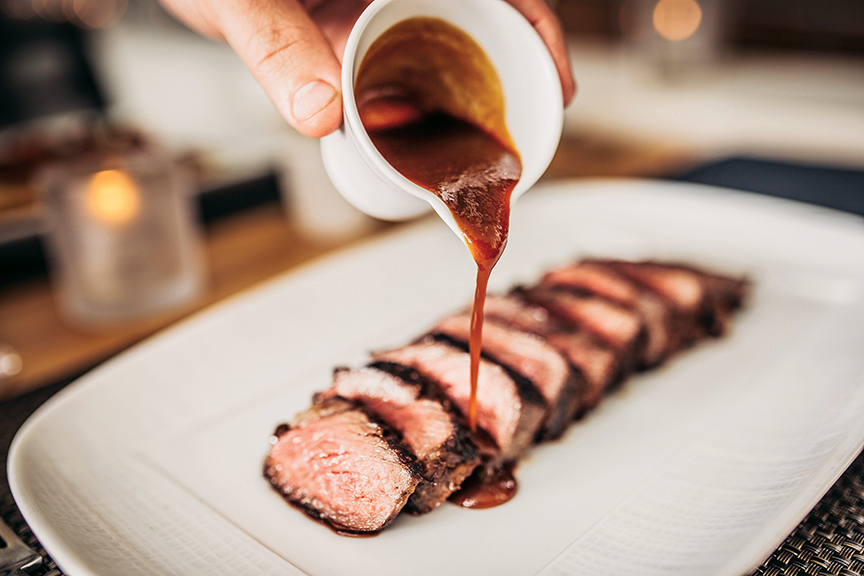
When CUT debuted a decade ago, it was a bold departure from the traditional steakhouse, from the cutting-edge aesthetic by famed modernist architect Richard Meier to a menu that included beef from around the globe and subtle Pacific Rim influences. Unlike the traditional chophouses, it did not ooze testosterone, and tables were just as likely to accommodate svelte models as button-down businessmen. CUT was among the first mainstream steakhouses to offer genuine Kobe beef, so heavily marbled from a pampered existence that just a few ounces satisfy.
“Our chefs are constantly challenging themselves, using ingredients and techniques that most steakhouses would never think to implement,” says Head Chef Ari Rosenson. While that may be reflected in dishes like bone marrow flan and maple-glazed pork belly with sesame-orange dressing, the chef points out that familiar items like creamed spinach, Kennebec fries and tempura onion rings are among the most popular sides. “We continue to evolve, creating experiences that are tailored to our guests, while also keeping it playful, unpredictable and true to our brand,” states Rosenson.
In Northern California, Alexander’s Steakhouse has emerged as a counterpoint to old school chophouses like San Francisco’s John’s Grill and Alfred’s. According to Vice President of Operations Josh Rousseu, the layering of innovative Pacific Rim influences over the traditional steakhouse template is driven by changing demographics, partially due to the region’s tech boom. “The inspiration for Alexander’s was rooted in the love and popularity of the classic American steakhouse, but elevated by Asian influences, ingredients and techniques to create a meld between the comfortable, accessible familiarity and unexpected surprises,” explains Rousseu.
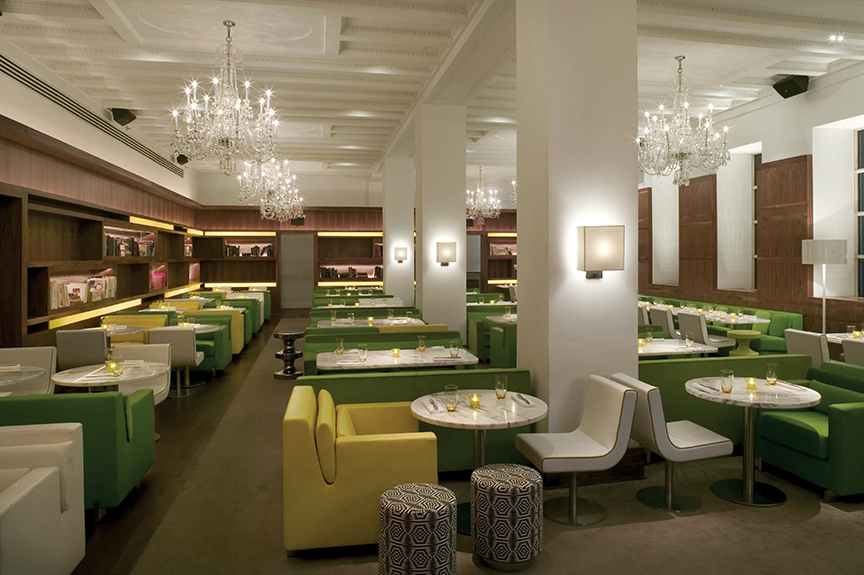
After launching in the Silicon Valley, Alexander’s next took over a former ware-house in San Francisco’s South of Market (SoMa) district, transforming it into a chic, contemporary space. Loyalists of old school steakhouses may be disappointed at the absence of an iceberg lettuce wedge or shrimp cocktail, but uni-oxtail toast and cured foie gras with blackberry honey and elderflower introduce sophisticated Japanese and French influences.
Steaks representing a wide array of appellations are offered at Alexander’s, from the American Heartland’s Black Angus to the “snow beef” wagyu raised in Hokkaido (Japan’s northernmost island), where cattle eat voraciously to combat frigid temperatures. Although most imported wagyu is incredibly rich and requires minimal seasoning, a selection of six exotic salts are provided.
Not all prized beef is from the Pacific Rim, and Long Beach, California’s Chianina is named after a legendary breed of cattle that Italians insist rivals the best of Japan or the American Midwest. For an opening act, diners may select from beef tartare, pork belly or roasted bone marrow with onion marmalade. The cuts of Chianina include bone-in ribeye, bone-in New York or bistecca alla fiorentina, and prestigious Piedmontese beef is also offered. The restaurant, a modern, approachable environment, features a strong wine program that is naturally deep in Italian reds but global in scope.
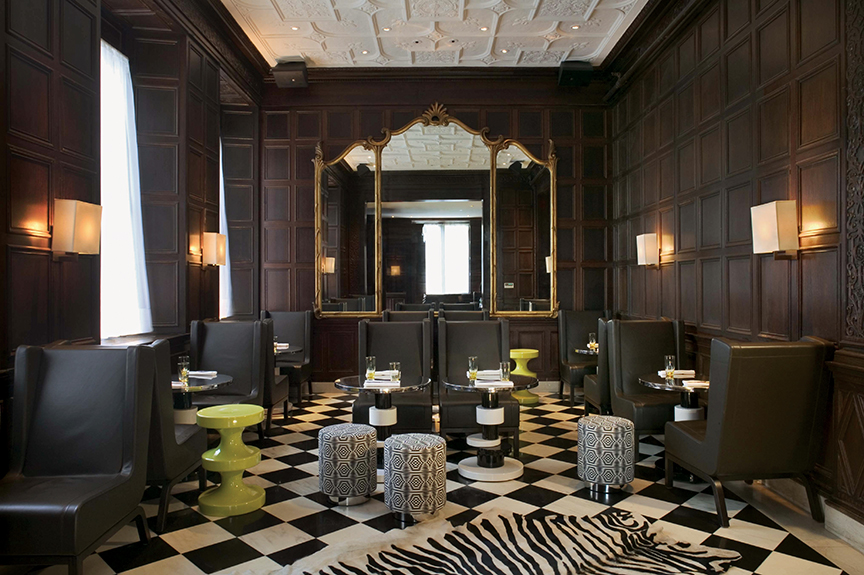
Prolific restaurateur Stephen Starr maintains a portfolio of about 30 diverse restaurants in the Northeast and Florida, including those of celebrity chefs Masaharu Morimoto and Douglas Rodriguez. Philadelphia’s Barclay Prime, with its chic, colorful décor — Baccarat crystal chandeliers are concessions to its historic Rittenhouse Square building — and contemporary soundtrack, has been called the “anti-steakhouse steakhouse.”
Executive Chef Mark Twersky’s menu includes some fun, whimsical items in addition to the requisite filet mignon and porterhouse, such as a monstrous 50-ounce tomahawk ribeye from Pennsylvania’s Baer Country Farm and Barclay Prime’s elevated riff on the iconic Philly cheesesteak. The $120 sandwich, which includes a half-bottle of Perrier-Jouët Champagne, is crafted from Japanese wagyu ribeye, foie gras and truffled Cheez Whiz. General Manager Tom Austin reports, “We’re filled with tradition and history in our own right, but stand in stark contrast to the old school classic steakhouse.”
Las Vegas has arguably become the steakhouse capital of America, with favorites from the Big Apple, Windy City and Lone Star State represented, as well as beef palaces created by celebrity chefs Mario Batali, Gordon Ramsay, and Jean-Georges Vongerichten. Top Chef star Tom Colicchio operates two steakhouses on the Strip: Heritage Steak, where beef from around the globe is grilled over an open flame, and Craftsteak, a sophisticated bastion of premium beef from the Heartland and Japan.
Colicchio is not one to overthink his cuisine. “My goal at Craftsteak is to find remarkable ingredients and cook in a way that preserves their integrity,” he says, adding, “It’s an amazingly simple idea.”
His Craftsteak menu includes braised, grilled and roasted cuts of beef, from USDA Prime to wagyu designated A5, the highest grade applied to the finest beef from Japan, complemented by a wine list filled with legendary (and stratospherically priced) vintages from Bordeaux. General Manager Christopher Goss reports the restaurant’s large menu offers opportunities for sharing and customizing. Despite the high prices, he insists, “We’re approachable to everyone, and while the cuisine may be an art, it’s not too highbrow and stands the test of time.”
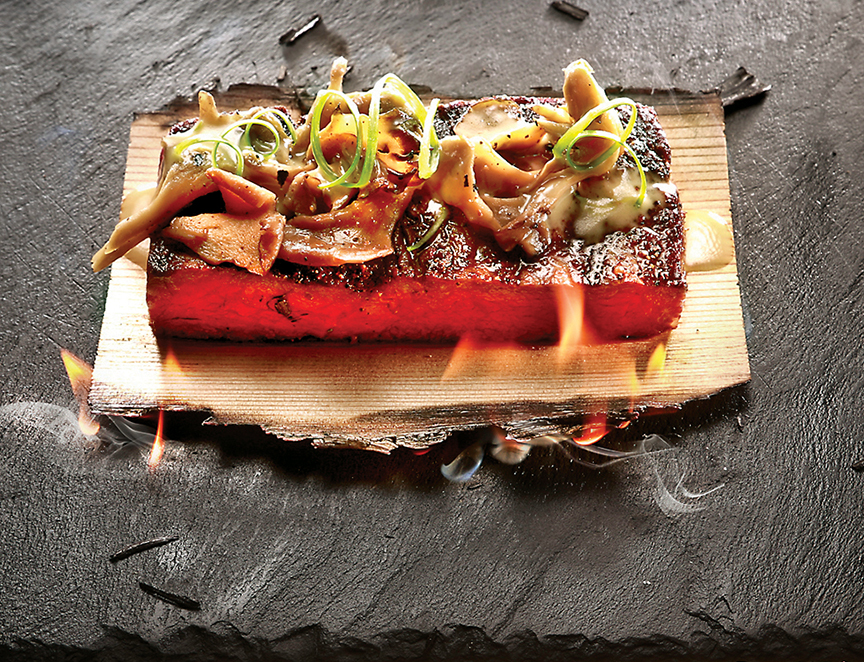
José Andrés, the Spanish-born celebrity chef who dominates the Washington, D.C., food scene, has stepped into the steakhouse arena at the trendy SLS Las Vegas. At his Bazaar Meat, he shows off some of the molecular gastronomic innovations he is famous for — tricks learned from his mentor, Spain’s pioneering chef Ferran Adrià — but he also respects the traditions of the American steakhouse.
In a chic environment created by groundbreaking designer Philippe Starck, Bazaar Meat is a modern, fanciful take on the traditional hunting lodge. Diners begin with Andrés signatures like foie gras cotton candy, otherworldly spherified olives and (literally) smoking liquid nitrogen cocktails, all reminders this ain’t your granddad’s steakhouse. Appetizers like beef tartare or bison carpaccio tacos reflect the meat-centric spirit, but the restaurant also offers an impressive raw bar from which oysters, sea urchin and live scallops are dispensed. And for high rollers, flights of caviar from around the globe can be paired with world-class Champagnes.
The steaks at Bazaar Meat include A5 Kobe from Japan’s Hyogo prefecture listed at $50 per ounce, prices equivalent to French black truffles. It is, however, worth noting that a few ounces of this ultra-rich, melt-on-your-tongue beef goes a long way and is best reserved for special occasions. Representing more bang for the buck is a whole, crackly-skinned suckling pig (a nod to the chef’s Spanish heritage), which can be pre-ordered for a memorable feast of what Andrés calls “the heart and soul of Bazaar Meat.”
Photos courtesy of Starr Restaurants


